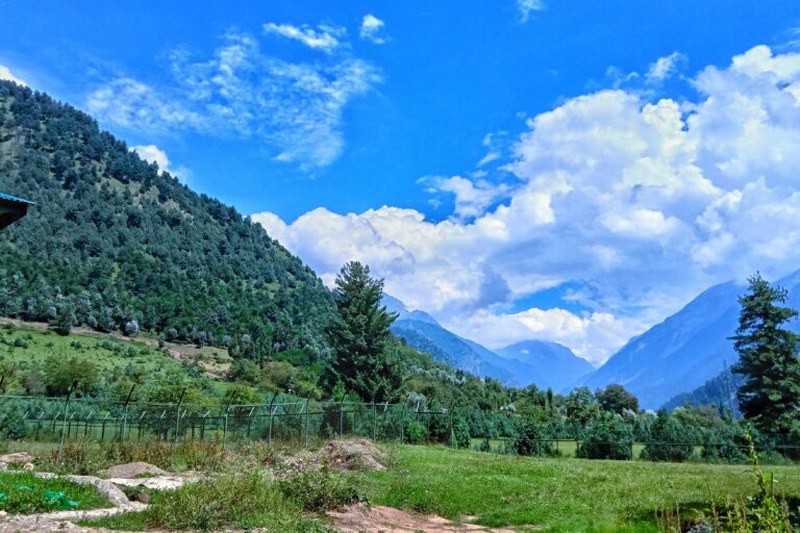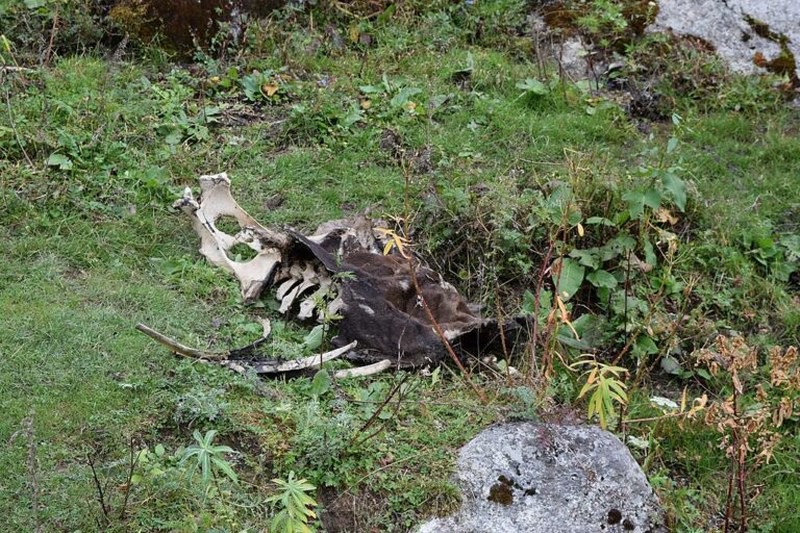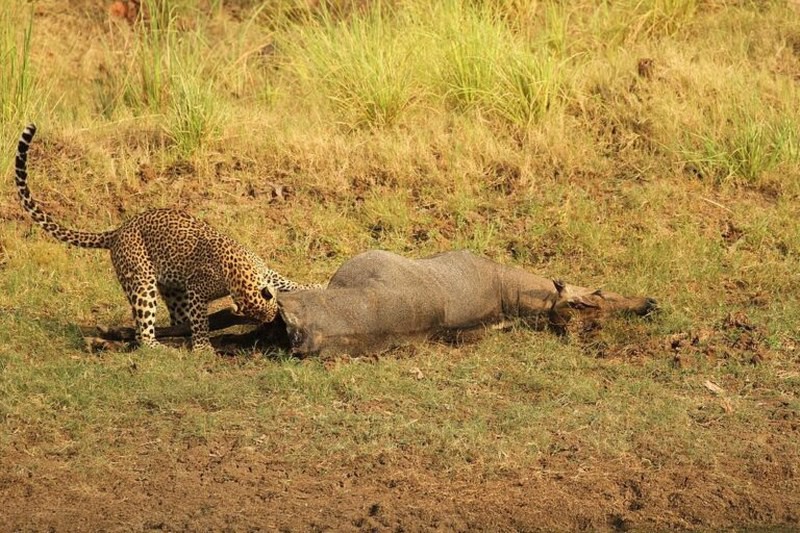South Kashmir The costs of coexisting with predatory wildlife
A new study across three protected areas in southern Kashmir recorded 92 livestock losses in two years from predators like the Asiatic black bear and the leopard, resulting in major financial strain for households in the buffer zones. While many respondents in the study expressed a generally positive attitude toward wildlife, without timely compensation and improved livestock protection, there is a risk of retaliatory killing. Habitat restoration, better grazing management, and strong community involvement are key to lasting coexistence. Mongabay India correspondent Sneha Mahale reports

In the forests and valleys of Kashmir, a quiet struggle plays out daily between local communities and two of the region’s most elusive predators — the Asiatic black bear and the leopard. In recent years, incidences of these carnivores attacking livestock for prey has become a growing concern. This poses a dual threat: it undermines rural livelihoods and jeopardises the long-term survival of these wild animals.
A new study examined livestock predation in three protected areas of southern Kashmir, to assess the economic toll of these losses and map the spatial patterns of such attacks.
“Much of the focus so far has been on human injuries and fatalities,” says co-author Bilal A. Bhat, senior assistant professor at the Department of Zoology, University of Kashmir. “However, for a more comprehensive understanding of human-wildlife interactions, it’s essential to also gather data on livestock predation and crop damage. This broader approach is critical for developing effective management strategies that balance human needs with wildlife conservation.”
Kashmir’s carnivore hotspots
The study by University of Kashmir researchers focused on Overa-Aru Wildlife Sanctuary, Achabal Conservation Reserve, and Rajparian Wildlife Sanctuary. These sites were selected for their varied human-wildlife interactions, land-use patterns, and socio-economic dynamics.
All three protected areas are surrounded by villages where farming and livestock rearing are a main source of livelihood. Overa-Aru, the largest, spans 425 square kilometres and is bordered by eight villages. Achabal has nine villages in its buffer zone, while Rajparian is more isolated, adjacent to just one village.
From January 2021 to December 2022, researchers surveyed 50 households across these three protected areas — 29 in Overa-Aru, 19 in Achabal, and two in Rajparian. Each had experienced at least one case of livestock loss during that time.
 Overa Aru Wildlife Sanctuary, one of the protected areas that was part of a study on livestock losses in southern Kashmir. Image by Suhayl091 via Wikimedia Commons.
Overa Aru Wildlife Sanctuary, one of the protected areas that was part of a study on livestock losses in southern Kashmir. Image by Suhayl091 via Wikimedia Commons.
Data was collected using a snowball sampling method, starting with reports from village heads and then verified through other residents. Where possible, researchers visited the sites to confirm attacks. Monthly check-ins with village heads were carried out over the two-year period to track new incidents. Affected livestock owners were interviewed to gather information about the attack, including details of the animals, timing, location, and predator species. GPS coordinates were recorded on-site using a handheld device or, where needed, estimated using Google Earth.
In total, 92 animals were lost — 59 in Overa-Aru, 30 in Achabal, and three in Rajparian. Most of those killed were sheep, followed by cattle, horses, and goats. Leopards were responsible for a majority of the kills.
“Sheep are often targeted due to their ideal size, lack of defensive behaviour, ease of capture, and wide availability,” explains Bhat. “We also observed surplus killing — where several animals are killed in a single attack — mainly by leopards, a pattern noted in other studies as well.”
Predators on the prowl
The researchers also found that the two predators exhibited distinct hunting patterns. While bears also targeted cattle, leopards preferred horses. Most attacks occurred during the summer months, especially in June and July. Both predators struck mostly during daytime, aligning with livestock grazing routines. This goes against conventional wisdom, which suggests leopards usually hunt at night.
The attack locations also varied. Bears typically stayed within forested areas, avoiding human settlements. Leopards, however, were bolder — some attacks took place inside livestock pens or near homes.
 The carcass of a cattle in Kangra district, Himachal Pradesh. Experts say that to understand and effectively manage human-wildlife interactions, data on livestock predation and crop damage is essential. Representative image by Ashish Gupta via Wikimedia Commons.
The carcass of a cattle in Kangra district, Himachal Pradesh. Experts say that to understand and effectively manage human-wildlife interactions, data on livestock predation and crop damage is essential. Representative image by Ashish Gupta via Wikimedia Commons.
As for the livestock themselves, no specific age group was consistently targeted. However, animals between four and six years old were slightly more vulnerable — possibly due to increased mobility or tendency to stray from the herd.
Counting the cost
The financial burden of these losses was substantial. In Overa-Aru, loss because of livestock predation amounted to nearly Rs. 13 lakhs (Rs. 1.3 million) over two years — more than Rs. 22,000 per affected household annually. In Achabal, losses reached Rs. 8.78 lakh (Rs. 878,000), with households averaging just over Rs. 23,000. Rajparian had fewer total losses, but the per-household cost was higher (around Rs. 40,000) due to the small number of respondents.
These amounts are significant for families who depend on agriculture and livestock. In most cases, no compensation was provided, fuelling frustration and increasing the risk of retaliatory killings.
Despite the hardships, many respondents expressed a generally positive attitude toward wildlife, acknowledging its ecological value. “Negative sentiment arises from the severe economic toll — especially among lower socioeconomic groups who rely on livestock for sustenance,” says Bhat. “This frustration increases the likelihood of retaliatory killings, posing a significant challenge to conservation.”
Addressing the critical role that the sample size plays in a perception study, Aniruddha Majumder, scientist and divisional in-charge, animal ecology division, State Forest Research Institute – Jabalpur, shares, “In this case, the very small sample size requires a clear and detailed justification, such as constraints like limited accessibility or logistical challenges. Additionally, perception studies involving human-carnivore interactions need to represent different age, sex, and other demographic groups to assess costs more accurately.” Majumder is not associated with this study.
 An Indian leopard with a kill in central India. The authors note that restoring prey populations within protected areas is crucial to easing conflict. Understanding where and when livestock attacks happen can also help authorities design more targeted responses. Image by Davidvraju via Wikimedia Commons.
An Indian leopard with a kill in central India. The authors note that restoring prey populations within protected areas is crucial to easing conflict. Understanding where and when livestock attacks happen can also help authorities design more targeted responses. Image by Davidvraju via Wikimedia Commons.
The way forward
The study also reveals a deeper truth: protecting wildlife isn’t only about conserving forests, it’s also about supporting the people who live alongside them. Understanding where and when attacks happen can help authorities design smarter, more targeted responses.
The authors note that restoring habitats and prey populations within protected areas are crucial to easing conflict. Involving local communities in habitat restoration, alongside clear demarcation of grazing zones, can help rebuild natural prey bases. Additionally, a timely and efficient compensation scheme could ease economic stress while supporting conservation goals. Likewise, funding for stronger corrals and improved livestock guarding, especially during high-risk summer months when herds move to higher altitudes, can reduce predation.
“Without timely intervention, both rural livelihoods and the future of large carnivores hang in the balance. Authorities, in collaboration with local communities, academic institutions, and NGOs, must adopt a comprehensive conflict management strategy, one that safeguards people and wildlife alike,” says Bhat.
Mongabay-India / TWF
IBNS
Senior Staff Reporter at Northeast Herald, covering news from Tripura and Northeast India.
Related Articles

Decade of slowing deforestation offers hope for forests: FAO data
Lush, green and brimming with trees and wildlife, forests are the Earth’s lungs and source of livelihoods for many communities.

Tamil Nadu on high alert as northeast monsoon intensifies, bringing heavy rains; cyclone risk looms over Bay of Bengal
Several districts across Tamil Nadu are on high alert as the northeast monsoon intensifies following its early onset, raising fears of a potential cyclone formation over the Bay of Bengal.

Despite 77.5% drop in stubble burning, Delhi’s air quality hits a five-year post-Diwali low
Despite a 77.5 percent drop in stubble burning. long seen as a primary cause of Delhi’s winter smog, the capital’s air quality collapsed to a five-year post-Diwali low on Tuesday morning, with PM2.5 levels averaging 488 micrograms per cubic metre, nearly 100 times the World Health Organization’s exposure limit.

Pakistani health department begins investigating two deaths as dengue cases spike
The Khyber Pakhtunkhwa Health Department has launched an investigation into the deaths of two people in Mardan, reportedly caused by dengue fever, as the province’s total number of infections rose to 3,638 with 37 new cases reported on Sunday.
Latest News

AI video shows '7 minutes' of Louvre theft, Netizens compare it to Dhoom 2

Russian drone attack targets kindergarten in Kharkiv, one dead, says Ukrainian President Zelenskyy

Female doctor assaulted in West Bengal state-run hospital, BJP targets TMC govt over 'women security'

India upgrades Technical Mission in Kabul to Embassy, days after Muttaqi's visit to New Delhi

